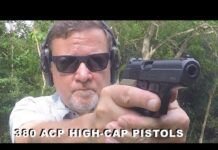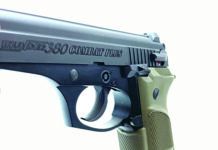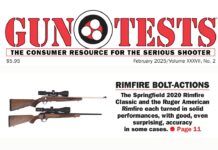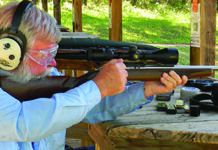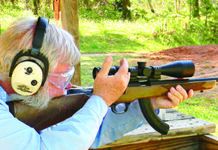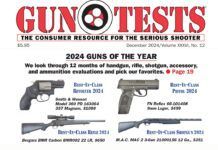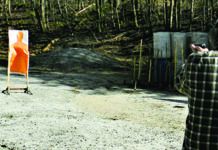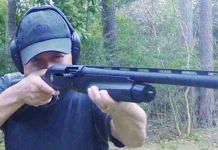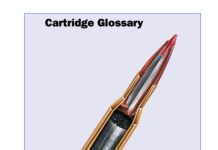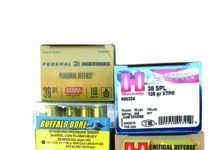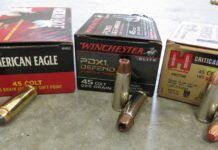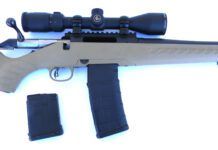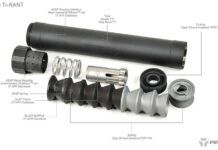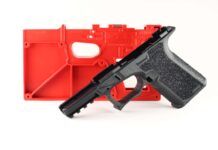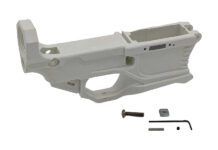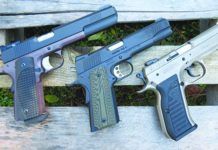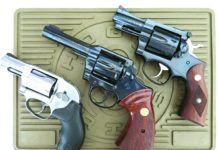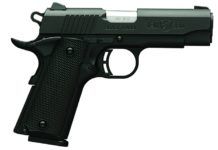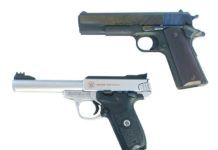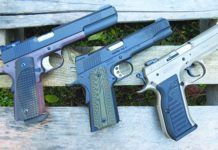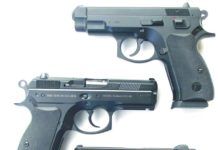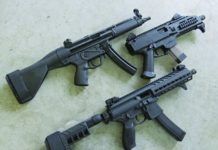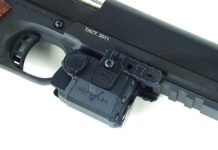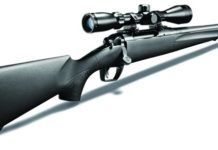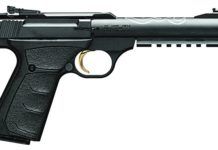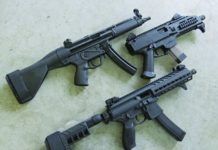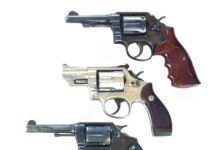10mms: How About the P220?
Neat comparison of 10mms; kinda hoping you'd toss the SIG P220 in 10mm into the mix. I thought your comments on the Kimber TLE II grips were interesting. I haven't shot that model, but I own a Kimber Custom Eclipse II in 10mm and have no such issue with my grips when firing up to 100 rounds in a session. For those who would like the edges less raspy, I use blue buffing on a buffing wheel mounted in my drill press to polish out G10 revolver and knife grips. It's not too aggressive, and you could take a little edge off without substantially changing the grip's appearance. Clean up with a little denatured alcohol and a toothbrush and you're ready for the range.
Good Buys, or Goodbyes? We Test Experienced Wheelguns
Before law enforcement changed over to semi-automatic pistols, most officers carried a 357 Magnum revolver. Though some write off revolvers as the firearms equivalent of rotary phones, many of our staff consider the revolver to be a simple-to-operate self-defense firearm with built-in safeties and no magazine to lose. We also like the 357 Magnum cartridge. In addition to self-defense use, some team members have used the round to hunt medium-size game, so power isn't an issue.
Because a good revolver stands the test of time and usage well, but also depreciates enough to become affordable for more folks, we assembled three used revolvers from what was once the big three of U.S. revolver manufacturers—Colt, Smith & Wesson and Ruger. In general, we would rate the condition of these revolvers from 80 to 90 percent by NRA standards—we could tell they have been used, but we could not see where they had been abused. All samples were chambered in 357 Magnum, and all were designed for self-defense with barrel lengths that ranged from 2.15 inches to 4 inches and double-action/single-action trigger modes. Safeties are built into these three revolvers. The S&W uses a hammer stop, while the Ruger and Colt use hammer transfer bars.
From that starting point, this pack then diverged, with each offering characteristics that ranged from thumbs-down to thumbs-up for our shooters. Some incorporated an excellent grip that helped tame the felt recoil of the 357 Magnum; some were slim and more easily carried concealed, and some were equipped with large, easy-to-align sights.
With any used revolvers, we have a process of testing the chamber-barrel alignment with a range rod, and we found all were aligned. We also check the timing to see how the cylinder rotates in DA mode and SA mode to ensure the chamber is aligned with the bore of the barrel. They were. We also look at the gap between the front of the cylinder and the forcing cone or rear of the barrel. We use a feeler gauge and expect to have .006 clearance. Any less and there is a chance the cylinder may bind after shooting as fouling builds up. Any more and the user might experience splatter from burning gases escaping from the gap. We also look for forward and rearward play in the cylinder when locked in the frame. These revolvers were tight and stood as good examples of the revolver manufacturers' art and science.
We tested accuracy at 25 yards, which pushed the envelope of these revolvers' capabilities, depending on the user. We also found these revolvers had good accuracy. In close-range testing, some of these revolvers could get lead downrange fast and in good groups. Test ammunition consisted of Winchester PDX1 Defender 357 Magnum with a 125-grain bonded jacket hollowpoint, Aguila 357 Magnum with a 158-grain semi-jacketed hollowpoint, and SIG Sauer 38 Special +P, loaded with a 125-grain jacketed hollowpoint.
We had no issues with any of the revolvers. They all performed in DA and SA mode and loaded and ejected empties if we did our part and used gravity to our advantage. We did find that the S&W had the advantage as a concealed-carry revolver, but the Ruger and Colt were quite capable. Here's what we found out about these handguns after the brass cooled.
Browning Adds Five New Pistols to Black Label 1911-380 Line
Browning has added new offerings to the Black Label 1911-380 pistol line.
The new Black Label 1911-380 Medallion Pro will be available in Full Size and Compact versions. These new pistols will feature an aluminum-reinforced composite frame and slide with a blackened stainless steel finish with silver brush-polished flats. Grips on this new model are checkered rosewood with a gold Buckmark logo. The pistol comes with two magazines. The Full Size model barrel length is 4.25 inches and the Compact barrel length is 3.625 inches. Both the Full Size and Compact versions are available with steel three-dot sights or steel night sights. Suggested Retail price with the 3-dot sights: $800. Suggested retail price with night sights: $880.
Browning is also adding three Compact models to the 1911-380 line in 2017. The Black Label 1911-380 Compact has the same features as the Black Label 1911-380 Full Size but with a 3.625-inch barrel. This model has composite black grips and includes fixed combat sights. Suggested retail: $670.
Browning is also adding Compact models to both the Black Label Pro and the Black Label Pro with Rail. Both of these models have 3.625-inch barrels and are available with either steel three-dot sights or steel night sights. The Black Label Pro Compact has a suggested retail price of $800 for the three-dot model and $880 for the night-sight model. The Black Label Pro Compact with Rail and three-dot sight has a suggested retail price of $830, and the railed night sight model has a suggested retail price of $910.
22-Caliber Handgun Shoot-Out: Smith, TacSol, Beretta, Colt
In this installment, we are looking at some of the best 22-caliber pistols for all-around target shooting and training for marksmanship and personal-defense practice, with an emphasis on viability for personal-defense training. Some handguns are just fine for general plinking, but the modern shooter demands the ability to train with combat lights or even a red-dot sight. All 22s do not allow this type of versatility. Let's look at four 22-caliber handguns and see how they stack up as modern trainers.
The 22 self-loading handgun is a great firearm that every handgunner should own at least one of. The 22 is a great trainer, and it is also a good small-game handgun, and it is even useful in some forms of competition. The absence of recoil and muzzle report compared to centerfire handguns is often touted, but recoil and muzzle blast are there, simply in easily manageable portions. The shooter is free to concentrate on trigger press, sight picture, sight alignment, and grip. Practice in offhand fire, combat practice, firing for extreme accuracy from a solid rest, clearing malfunctions and hunting game are just some of the practice that may be accomplished with the 22 pistol. For small-game hunting, excellent accuracy is demanded. For combat practice—and this is an important point—the handgun should be similar to the centerfire defense gun in accuracy. In that manner, the shooter isn't given a false sense of security by a 22 that is much more accurate than the 9mm or 45 they use for personal defense. When practicing with the 22, the serious shooter should use the same grip and trigger press that he or she uses when mastering the 9mm or 45. Using a lighter grip or shooting fast just because the 22 is so controllable doesn't cross over into personal defense skills; it is simply shooting for fun.
We collected two 22-caliber handguns and two 22-caliber conversion units for comparison. One of the handguns is a new model and the other, a relatively new and often overlooked pistol. The firearms tested included the Smith & Wesson Victory 22, Beretta Neos 22, Tactical Solutions' Glock conversion unit, and a Colt 22 Ace conversion unit.
Three More 10mm Autos: Kimber, Dan Wesson, Tanfoglio
Last year we tested three 10mm Auto pistols and found there was a lot of interest in these big-bore handguns, so we decided to return to these powerful handguns for another look. Our most recent crop of 10mms includes two 1911 platforms and one based on the CZ 75 platform. The Kimber Custom TLE II and the Dan Wesson Bruin Bronze share the 1911 platform, while the Tanfoglio Witness is based on the CZ 75 design. We liked all three of these pistols and found that all three could serve multiple duties from hunting to self-defense. Since the 10mm has the power of a 41 Magnum, we feel it is a bit much for everyday carry. If we ever were in a shooting incident, it's possible the overpenetration of the 10mm could be a liability. But in a self-defense situation where you are facing an angry bear in the back country, we think the 10mm Auto makes perfect sense. Also, as a hunting round, the 10mm offers a lot of power and is well suited for game like deer and pigs at short distances. We'd even use it in a tree stand to take black bears visiting a bait.
All three pistols ran exceptionally well with no malfunctions or jams, and we found they were accurate. Two-inch five-shot groups at 25 yards were the norm. For ammunition, we used SIG Sauer V-Crown Ammunition loaded with an 180-grain JHP bullet. The SIG ammo was loaded to velocities that 10mm Auto was designed for.
The other two loads were Federal American Eagle and Armscor USA labels, both using 180-grain FMJs. These two rounds weren't as hot as the SIG load, as the table data reveal. The SIG ammo factory data shows a muzzle velocity of 1250 fps; we got very close to that muzzle velocity from the Kimber and Dan Wesson. The Tanfoglio produced less velocity. The Federal and Armscor ammo is factory-speed stamped at 1030 fps and 1008 fps, respectively. With the three pistols, we saw higher muzzle velocities than the factory figures.
For accuracy testing, we used a rest and open sights, firing at targets placed 25 yards downrange. For our speed stage, we fired at 10 yards. A fast and accurate follow-up shot was faster with the Bruin and Witness, which we will get into shortly. Remember that a 10mm Auto is not a learner's pistol or for those who are sensitive to recoil. In our opinion, the Bruins and the Witness helped us manage recoil the best. Shooting this trio side by side at the range, we learned a lot about them. Here's the skinny on all three.
Compact 9mms: Canik, CZ-USA, and Arex
In this issue, we test four compact handguns chambered for the 9mm Luger cartridge, the most popular defensive cartridge, according to sales figures compiled by the Bureau of Alcohol, Tobacco, Firearms, and Explosives. The 9mm offers real power in a compact high-pressure cartridge. The handguns that chamber the cartridge are often very reliable, and modern loads have a lot going for them. A service-size pistol is too large for many people to carry concealed and are unwieldy in home-defense situations for others as well. As a result, the ideal 9mm handgun would seem to be a compact version of the service pistol. These are service handguns with a shorter grip and slide that makes the piece easier to carry and for many of us, easier to handle under pressure. But the short slide radius may make precision shooting more difficult.
Some prefer a decocker on their double-action-first-shot handguns, but there is a smaller, but dedicated, group that prefers the selective-double-action type and others perhaps would like to have both. These shooters do not care for the Glock or a double-action-only system and often choose a CZ or SIG-type handgun. We fired off a variety of compact 9mm handguns and came to a conclusion, based on the opinion of our testers, as to which handgun is the best suited for most shooters, with the emphasis on the beginning, but still competent, shooter. Some of the choices are subjective, but the objective components — accuracy and reliability — are most important. If a compact 9mm fits your needs for self defense, one of these handguns will be a good choice, and one will be the best choice, we believe.
Big 9mm Pistols Tested? Yes!
The March 2017 issue compared "Forward-Mounted-Mag 9mm Pistols from SIG, Zenith, & CZ." The three super-sized pistols tested included the Zenith Firearms MKE Z-5RS with SB Brace, the CZ Scorpion EVO 3 S1, and the SIG Sauer MPX-PSB. The Zenith and SIG came with braces, while the CZ did not, but one could be purchased separately. All three proved to have good accuracy and reliability as defensive firearms. We preferred the Zenith, though the SIG and CZ performed well. As a subscriber, log on to Gun-Tests.com and read the entire review, either the online version or download the whole issue as a PDF.
Four Affordable 1911 Rail Guns
Guns fitted with accessory rails, aka rail guns, are a popular choice for both self defense and home defense because of their ability to mount a combat light or advanced laser. These are nice features to have on a defense handgun, but they must be paired with features that make a difference to accuracy, reliability, and handling, such as a speed safety and a well-designed beavertail and functional grip safety on their 1911s. Good sights and a crisp trigger response are always important factors as well. But the most important factor is reliability.
308 Winchester Bolt-Actions: Remingtons M783 Rifle Wins
Among the most useful, versatile, and powerful all-round sporting rifles is the 308 Winchester bolt action. These rifles are accurate, reliable, and can take on small to big game in many hunting conditions. When married with a good optic and in competent hands, they are well suited to take a 200-pound target at 200 yards and beyond, as a rule of thumb. The chambering is a joy to use and fire, compared to hard-kicking magnums, and offers plenty of recreational value. The bolt-action 308 is also a useful tactical rifle in many situations, and the round is widely used by law enforcement across the country.
We recently took a hard look at four bolt-action rifles chambered in 308 Winchester, with a special emphasis on looking for affordable options. So we chose two used rifles and one lower-cost new rifle and compared them to a rifle in a higher price range to ensure we weren't missing something that more dollars could provide. These rifles included the now-discontinued Mossberg ATR, the Remington 783, the Remington 700 SPS, and the Savage Axis. In this quartet, we shot three loads for accuracy testing and another load in offhand fire to gauge the accuracy of the rifles. As it turns out, the economy combination rifle that comes from the factory with a bore-sighted scope is a good deal. Though the Remington 783 was the most accurate rifle, we also liked the Remington 700 SPS a lot. Overall, however, the Savage Axis combination seems a best buy. Let's look hard at these rifles and delve into why we made these choices and to see if you agree with our assessments.
New Handguns at SHOT 2017
The New Black Label 1911-22LR Gray full-size and compact models are available with or without a rail. The slides on both are machined aluminum, and the barrel has a gray anodized finish. The frames are composite, with a machined 7075 aluminum subframe and slide rails. Sights are fiber-optic. SRP: $699.99; $719.99 with the rail. A Black Label 1911-22LR Medallion full size and compact will also be offered with similar features for $670.
The Black Label 1911-380 Medallion Pro model, in full-size and compact versions, features a matte-black frame and a blackened stainless-steel slide with silver brush-polished flats. The grips are made of intricately checkered rosewood with a gold Buckmark. Barrel length on the full-size model is 4 inches; on the compact model, it's 3 5⁄8 inches. SRP: $800; $880 with night sights. Black Label 1911-22LR Medallion full-size and compact versions will also be offered with similar features for $670.
Forward-Mounted-Mag 9mm Pistols from SIG, Zenith, & CZ
In the October 2016 issue, we tested three high-capacity 9mm Luger pistols and found them somewhat lacking in defensive scenarios, though we did enjoy shooting one, the MPA Defender, which was sized more like a regular pistol than the carbine-like SIG MPX and which functioned better than an Uzi Mini Pro. But there are an increasing number of pistols that, save for a couple of features, function more like Short-Barreled Rifles (SBRs), which are controlled by much more stringent regulations under the National Firearms Act and are vastly more expensive and hard to get. The SIG MPX-PSB, for example, is similar to the unit we tested last October except it comes with a Stabilizing Brace, thus the "SB" in the name, compared to the "P" designation we initially tested.
This round, we found products more alike in size to the SIG Sauer MPX-PSB, namely, the CZ Scorpion EVO 3 S1 and the Zenith Firearms MKE Z-5RS with SB Brace. The Zenith and SIG came with a stabilizing brace, while the CZ did not, but it could be purchased separately. The SIG, CZ, and Zenith are tactical looking firearms because they all have a military ancestry that is especially noticeable due to the magazine mounted in front of the trigger guard and not in the grip. The three pistols tested are all semi-automatic, require two hands to shoot with any degree of accuracy, use high-round-capacity magazines compared to typical full-size handguns, and have the ability to be fired with a stabilizing brace. These pistols also represent three different operating mechanisms: the SIG uses a short push-rod gas system; the CZ a simple blowback system, and the Zenith a delayed roller-block mechanism. During firing, we noticed big differences in the mechanisms in both manual operation and cycling when fired, which we will get into. The ergonomics and controls differed as well, yet we found our ramp-up time transitioning between handguns to be short.
Initially, there is an awkwardness shooting these pistols because they feel like an SBR yet have no stock for a steady aim, and they are too heavy to fire in a Weaver, Isosceles, or hybrid stance with a two-hand hold like a typical handgun. We believe adequate range time and proper training is needed to master these pistols.
Most important, we wondered if, out of the box, these similar, yet different, pistols would work as home-defense choices. In our opinion, the upside of these three pistols is that they offer high magazine capacities, decent accuracy, and a lot of shooting fun. Yes, these pistols can make empty brass very quickly. On the downside is cost. Yes, you can purchase a lot less gun for a lot less money and achieve the same self-defense goal as what this trio delivers, we believe. Still, we looked forward to seeing what each firearm could do at the range.
Used 38 Sp. Revolver Contest: Colt, Smith & Wesson, Ruger
Revolvers make excellent home-defense handguns. They are simple to use and reliable and will come up shooting after long periods of storage. There are no springs compressed when the revolver is loaded, and no magazines to keep up with. The revolver may be chambered for powerful and efficient cartridges, such as the 38 Special +P and the 357 Magnum. For shooters able to engage in only minimal training, the revolver makes a lot of sense. Conversely, many very experienced shooters trust the revolver and little else. The smooth-rolling double-action trigger helps avoid flinch and the rhythm, once learned, allows excellent hit probability.
We set out to find four used revolvers for this Bargain Hunter segment. They had to be high quality and chambered for either the 38 Special or 357 Magnum cartridge, with the emphasis on 38 Special. While most homeowners will load these revolvers with 38 Special ammunition, the 357 Magnum is certainly a viable option, so we tested the revolvers chambered for the Magnum cartridge with these heavy loads as well. Because we were looking for bargains, we limited the used cost to a maximum of $500 counter price. We found one revolver at that maximum and three for considerably less, including two revolvers at $300. We chose medium-frame revolvers for two of the handguns and small frames for the other two handguns.
Three were six-shot revolvers and one was a five-shooter. We elected not to pursue heavy-frame revolvers, such as the Smith & Wesson L frame or Ruger GP100, and we also did not look for J-frame type snubnose revolvers. Basically, we were looking for affordable houseguns that would do a credible job of home defense if called upon. The contenders were as follows


